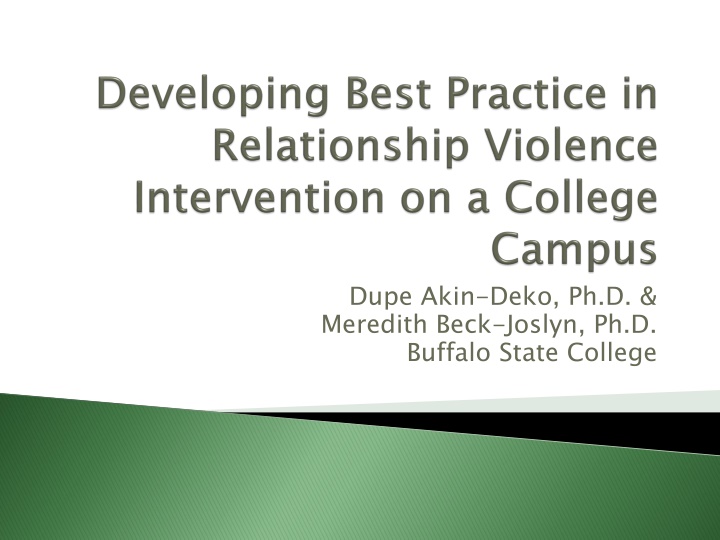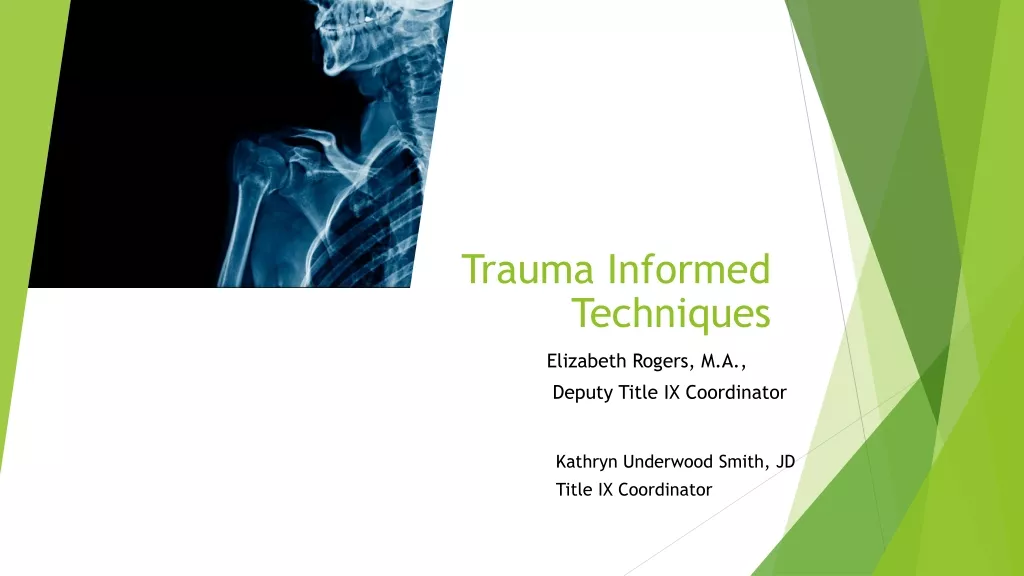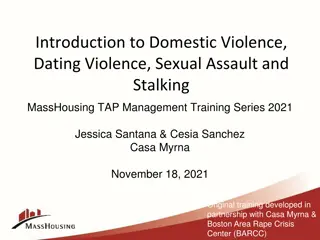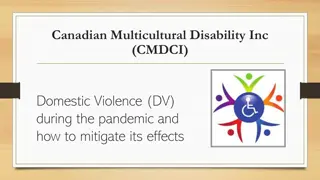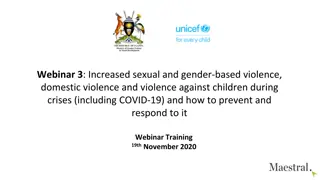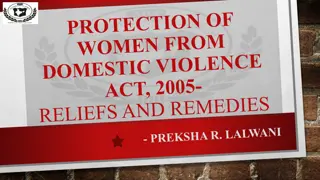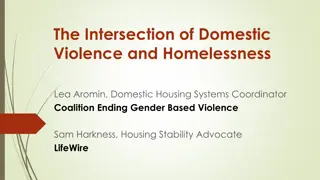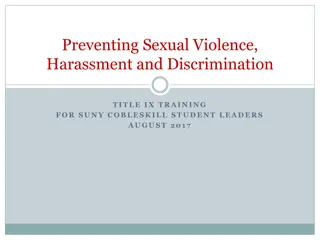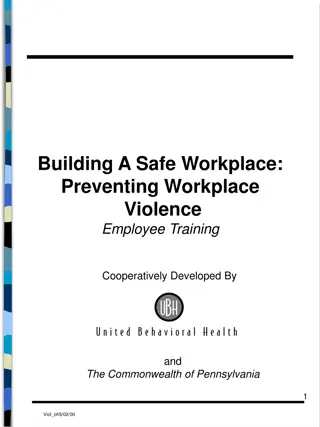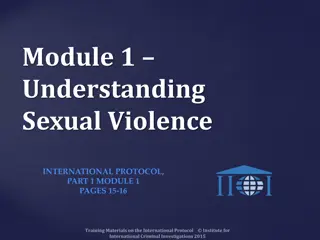Recognizing and Addressing Relationship Violence on College Campuses
Relationship violence, encompassing various forms of abuse such as physical, emotional, economic, psychological, and sexual, is a prevalent issue affecting individuals in intimate relationships or households. The abuser typically seeks power and control over the victim through coercive behavior. Shockingly, statistics reveal that a significant number of women experience relationship violence in their lifetime, with college-aged individuals being particularly vulnerable. Identifying and combating abusive behavior within college relationships is crucial for creating safer campus environments.
Download Presentation

Please find below an Image/Link to download the presentation.
The content on the website is provided AS IS for your information and personal use only. It may not be sold, licensed, or shared on other websites without obtaining consent from the author.If you encounter any issues during the download, it is possible that the publisher has removed the file from their server.
You are allowed to download the files provided on this website for personal or commercial use, subject to the condition that they are used lawfully. All files are the property of their respective owners.
The content on the website is provided AS IS for your information and personal use only. It may not be sold, licensed, or shared on other websites without obtaining consent from the author.
E N D
Presentation Transcript
Dupe Akin-Deko, Ph.D. & Meredith Beck-Joslyn, Ph.D. Buffalo State College
Review Relationship Violence Review Relationship Violence Implication for intervention and prevention on College campuses Implication for intervention and prevention on College campuses Case Reviews Case Reviews Self Care Self Care Wrap Wrap- -up up
Relationship violence is any kind of abuse that takes place in a relationship or household. It can involve lovers, former spouses, ex Relationship violence is not a singular event but a pattern of assaulting and coercive behavior utilized by the abuser against the victim. Other terms used include Domestic Violence and Intimate partner violence. Relationship violence is any kind of abuse that takes place in a relationship or household. It can involve lovers, former spouses, ex- -lovers, roommates, etc. Relationship violence is not a singular event but a pattern of assaulting and coercive behavior utilized by the abuser against the victim. Other terms used include Domestic Violence and Intimate partner violence. lovers, roommates, etc.
The main purpose of abuse is to power and control Five forms of relationship violence exist: Physical Emotional Economic Psychological Sexual The main purpose of abuse is to maintain power and control!! !! Five forms of relationship violence exist: Physical Emotional Economic Psychological Sexual maintain
One in four women will experience relationship violence in her lifetime An estimated 1.3 million women are victims of physical assault by an intimate partner each year 24% of IPV homicides are males Females who are 20 the greatest risk for intimate partner violence One in four women will experience relationship violence in her lifetime An estimated 1.3 million women are victims of physical assault by an intimate partner each year 24% of IPV homicides are males Females who are 20- -24 years of age are at the greatest risk for intimate partner violence 24 years of age are at
Abusive behavior is common in college relationships In a study, 1 in 4 college male student reported battering a previous or current female partner (Silverman and Williamson, 1997) 21% unmarried college women reported having been physically assaulted by a current or previous romantic partner. (Luthra and Gidycz, 2001) Abusive behavior is common in college relationships In a study, 1 in 4 college male student reported battering a previous or current female partner (Silverman and Williamson, 1997) 21% unmarried college women reported having been physically assaulted by a current or previous romantic partner. (Luthra and Gidycz, 2001)
Women in dating relationships perpetrate more violence (grabbing, shoving, slapping, throwing things) against their partners than men (Luthra and Gidycz, 2006) Greater percentage of dating partners are psychologically abused than are physically abused Psychological abuse may precede physical abuse Women in dating relationships perpetrate more violence (grabbing, shoving, slapping, throwing things) against their partners than men (Luthra and Gidycz, 2006) Greater percentage of dating partners are psychologically abused than are physically abused Psychological abuse may precede physical abuse
Increased sexual behaviors with multiple partners Suicide attempts Episodic heavy drinking Depression Anxiety Poor Grades Can be an enduring feature of relational pattern Increased sexual behaviors with multiple partners Suicide attempts Episodic heavy drinking Depression Anxiety Poor Grades Can be an enduring feature of relational pattern
Workshops Credit bearing courses Clinical groups Classroom presentations
Interventions aimed at preventing the occurrence of dating violence have shown decreased violent behaviors Fostering skills for the development of strong and healthy relationships has been identified as a key target for dating violence prevention. Interventions aimed at preventing the occurrence of dating violence have shown decreased violent behaviors Fostering skills for the development of strong and healthy relationships has been identified as a key target for dating violence prevention. Interventions focused on general relationship skills and partner selection may have larger impact Interventions focused on general relationship skills and partner selection may have larger impact
Normative and/or corrective feedback could be incorporated into interventions to assist students in making healthy, proactive choices Normative and/or corrective feedback could be incorporated into interventions to assist students in making healthy, proactive choices Interventions should consider women s experiences could be as victims, perpetrators, or both Interventions should consider women s experiences could be as victims, perpetrators, or both
J is a 19 y o junior. She transferred last semester, and home is 5 hours away. Her parents are going through a divorce and everything on the home scene seems to be different and chaotic. She is in love with Greg. They have been going out since she was 16 and he was a big part of why she transferred to this college. He makes her feel very important and loved. Greg is an RA and has a single room. J literarily lives there and spends all her free time with him. There is an assumption that they will marry after college so she finds herself doing his laundry, cooking sometimes, packing breakfast or taking his dinner to him when he is on duty. It used to be fun. She tells him where she is at all times of the day. They call it their checking in time even though she is the only one who does it. J knows Greg has a temper and tries not to provoke it. He has never laid hands on her but has broken her stuff in the past; like when she had forgotten to check in and went with her study group to Starburst for coffee (he smashed her i-phone) or when she had offered one of his suitemates a bowl of chili (threw and broke her favorite serving bowl her grandma had given her). On occasion, Greg had gone ballistic, called her all sorts of names and accused her of flirting and cheating. His statement, maybe like your mom, you will not be able to keep your home and marriage together still stings. He is so confusing. He openly flirts with residents when he is on front desk duty, in the elevator or meets them in the corridor. When she brings it up, he says that it s part of his job, to get good evaluation, know his residents, and make them comfortable in their environment. This semester, her grades are starting to suffer because in addition to her academic assignments, she is doing a lot of Greg s assignments and reports. At times she feels trapped. She is not sleeping well and is aware that she is losing weight. She can t afford to lose him too. She does not really have friends here. When he is happy, he is really such a wonderful person.
Listen to her story in detail and validate her experience Acknowledge her fear, and the risk she takes in speaking with you Recognize and label abusive behavior Treat her feelings of fear, anger and love as legitimate Try to understand the reasons for her choices. Don t assume her decisions are irrational, or that having been abused means she needs psychotherapy Keep strict confidentiality Leave her in control of decisions that affect her Make safety a high priority Listen to her story in detail and validate her experience Acknowledge her fear, and the risk she takes in speaking with you Recognize and label abusive behavior Treat her feelings of fear, anger and love as legitimate Try to understand the reasons for her choices. Don t assume her decisions are irrational, or that having been abused means she needs psychotherapy Keep strict confidentiality Leave her in control of decisions that affect her Make safety a high priority
Start from the assumption that an abuser is dangerous. If he has tried to kill her in the past, he is likely to do so again Ask in detail about the risks she faces Try to help your client identify the circumstances under which her partner typically becomes violent. Trust your client s judgment. Don t ask her to substitute your judgment for her own If she seems you, explore why not. danger or minimizing her partner s violence because he demands that she do so. Ask how her perception of danger has changed over time, and whether anything has happened recently that changes her assessment Start from the assumption that an abuser is dangerous. If he has tried to kill her in the past, he is likely to do so again Ask in detail about the risks she faces Try to help your client identify the circumstances under which her partner typically becomes violent. Trust your client s judgment. Don t ask her to substitute your judgment for her own If she seems not you, explore why not. She may be missing some cues of danger or minimizing her partner s violence because he demands that she do so. Ask how her perception of danger has changed over time, and whether anything has happened recently that changes her assessment not to perceive danger which looks real to She may be missing some cues of to perceive danger which looks real to
The main risk factors are not psychological, but concrete and behavioral: Separation (especially if it occurred recently) Stalking. Escalation of abuse Threats (to kill her, the children or himself; to take the children) Abuser has access to guns and/or has used weapons in the past Abuser s use of drugs or alcohol, especially during violent assaults Abuser is depressed or suicidal victim Victim lacks access to sources of assistance and support either because of the abusers behavior or for other reasons The main risk factors are not psychological, but concrete and behavioral: Separation (especially if it occurred recently) Stalking. Escalation of abuse Threats (to kill her, the children or himself; to take the children) Abuser has access to guns and/or has used weapons in the past Abuser s use of drugs or alcohol, especially during violent assaults Abuser is depressed or suicidal this poses a risk to the victim. . Victim lacks access to sources of assistance and support either because of the abusers behavior or for other reasons this poses a risk to the
Work with the client to evaluate all treatment and discharge plans to determine whether following them might further endanger her or unintentionally reinforce her partner s control Don t try to be the expert better than anyone Decide how contact between you and her can be handled most safely See individual violent incidents as part of a pervasive, ongoing attempt to control her Look beyond the current crisis and plan for safety during periods of relative calm Identify high should include: Her partner s use of tactics that target her specific life situation (such as health or disability issues, sexual orientation, etc.). Ways in which her partner may attempt to interfere with her efforts to get help, for instance demanding to attend her sessions, or texting her during sessions, and how she wants to respond to such interference. Work with the client to evaluate all treatment and discharge plans to determine whether following them might further endanger her or unintentionally reinforce her partner s control Don t try to be the expert the client knows her risks, and her partner, better than anyone Decide how contact between you and her can be handled most safely See individual violent incidents as part of a pervasive, ongoing attempt to control her Look beyond the current crisis and plan for safety during periods of relative calm Identify high- -risk situations and make specific plans for each one. This should include: Her partner s use of tactics that target her specific life situation (such as health or disability issues, sexual orientation, etc.). Ways in which her partner may attempt to interfere with her efforts to get help, for instance demanding to attend her sessions, or texting her during sessions, and how she wants to respond to such interference. the client knows her risks, and her partner, risk situations and make specific plans for each one. This
Identify signals of impending danger as far ahead of the actual violence as possible, so she is more able to avoid violence or escape injury. Take her partner s threats seriously through on past threats. Not put too much stock in her partner s promises to change seldom stop just because they say they will. Connect with domestic violence service providers and other resources. Assess the safety implications of interventions by others, such as: A judge imposing a mutual order of protection. Her partner s therapist pushing for couple counseling. Assess the costs and benefits of calling the police, getting an order of protection, using domestic violence services, or disclosing abuse to friends or family. Rehearse her safety plans, imagine ways they could backfire. For instance, the violence could escalate or there could be legal problems. Help her come up with back her plans are working. Identify signals of impending danger as far ahead of the actual violence as possible, so she is more able to avoid violence or escape injury. Take her partner s threats seriously especially if he has followed through on past threats. Not put too much stock in her partner s promises to change abusers seldom stop just because they say they will. Connect with domestic violence service providers and other resources. Assess the safety implications of interventions by others, such as: A judge imposing a mutual order of protection. Her partner s therapist pushing for couple counseling. Assess the costs and benefits of calling the police, getting an order of protection, using domestic violence services, or disclosing abuse to friends or family. Rehearse her safety plans, imagine ways they could backfire. For instance, the violence could escalate or there could be legal problems. Help her come up with back- -up plans and periodically assess how well her plans are working. especially if he has followed abusers up plans and periodically assess how well
Discuss with team and director Identify and use peer for emotional support and debriefing Consider implication for following offices: Residence Life Office Judicial Office University Police Dean of Students Academic Departments Pertinent organizations e.g. Athletics, sororities, frats Discuss with team and director Identify and use peer for emotional support and debriefing Consider implication for following offices: Residence Life Office Judicial Office University Police Dean of Students Academic Departments Pertinent organizations e.g. Athletics, sororities, frats
Discuss how best to respond to presented case Identify the most salient concerns and related response in keeping with best practice. How will your response change if You get information the perpetrator is a heavy AOD user There is access to a weapon Client comes in with new bruises You heard about the situation from one of your clients (a friend of the victim who attends your school) A faculty or staff member who came to consult. Discuss how best to respond to presented case- - immediately, the short and long term . Identify the most salient concerns and related response in keeping with best practice. How will your response change if You get information the perpetrator is a heavy AOD user There is access to a weapon Client comes in with new bruises You heard about the situation from one of your clients (a friend of the victim who attends your school) A faculty or staff member who came to consult. immediately, the short and long term .
What kinds of peer and other forms of supervision are available to me? How safe do I feel in making use of such resources? What would I need to develop a consultation or supervisory relationship in which I felt able to openly express genuine concerns potentially or actually affecting my work as a therapist? What kinds of peer and other forms of supervision are available to me? How safe do I feel in making use of such resources? What would I need to develop a consultation or supervisory relationship in which I felt able to openly express genuine concerns potentially or actually affecting my work as a therapist?
Promote Wellness: Taking Care of Ourselves at work Promote Wellness: Taking Care of Ourselves at work Use consultations and supervision regularly Use an interdisciplinary approach Belong to a professional organization Practice risk management Good practice management Continuing education Be involved in your own therapy Use consultations and supervision regularly Use an interdisciplinary approach Belong to a professional organization Practice risk management Good practice management Continuing education Be involved in your own therapy
Promote Wellness: Taking Care of Ourselves at Home Promote Wellness: Taking Care of Ourselves at Home Warn your family members and friends about the hazards of the profession Be involved in non Be involved in your community Take time off from your practice or go on vacation Attempt to diversify your friendships Separate the therapeutic mode from family mode Create a Balance Warn your family members and friends about the hazards of the profession Be involved in non- -professional activities Be involved in your community Take time off from your practice or go on vacation Attempt to diversify your friendships Separate the therapeutic mode from family mode Create a Balance professional activities
Berkel, Furlong, Hickman, Blue; (2005). A Qualitative Examination of Black College Women s Beliefs About Abuse in Relationships. Professional Psychology: Research and Practice, 36, 283-290. Coker, Sanderson, Cantu, Huerta, Fadden; (2008). Frequency and Types of Partner Violence Among Mexican American College Women. Journal of American College Health, 56, 665-673. Daley & Noland; (2001). Intimate Partner Violence in College Students: A Cultural Comparison. The International electronic Journal of Health Education, 4, 35-40. Niolon, Whitaker, Feder, Campbell, Wallinder, Self-Brown, Chivers; (2009). A Multicomponent Intervention to Prevent Partner Violence Within an Existing Service Intervention. Professional Psychology: Research and Practice, 40, 264-271. NYS Resources http://www.opdv.state.ny.us/professionals/mental_health/index.html Pearlman, L.A. & MacIan, P.S. (1995). Vicarious traumatization: An empirical study of the effects of trauma work on trauma therapists. Professional Psychology: Research and Practice, 26, 558-565. Schwartz, Magee, Griffin, Dupuis; (2004). Effects of a Group Preventive Intervention on Risk and Protective Factors Related to Dating Violence. Group Dynamics: Theory, Reasearch, and Practice, 8, 221-231. Stein, Tran, Fisher; (2009). Intimate Partner Violence Experience and Expectations Among College Women in Dating Relationships: Implications for Behavioral Interventions. Violence and Victims, 24, 153-162.
